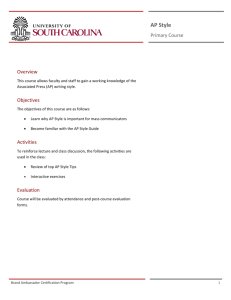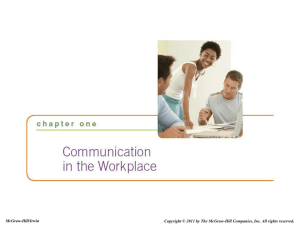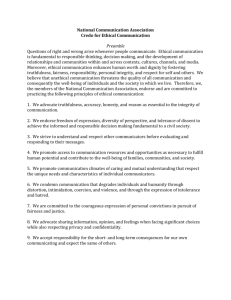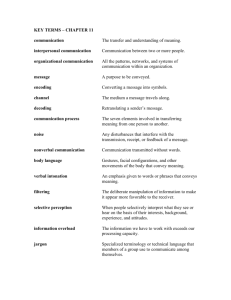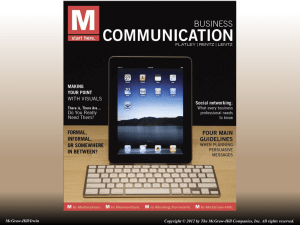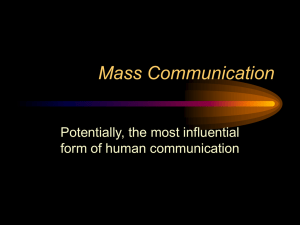Business Communications
advertisement
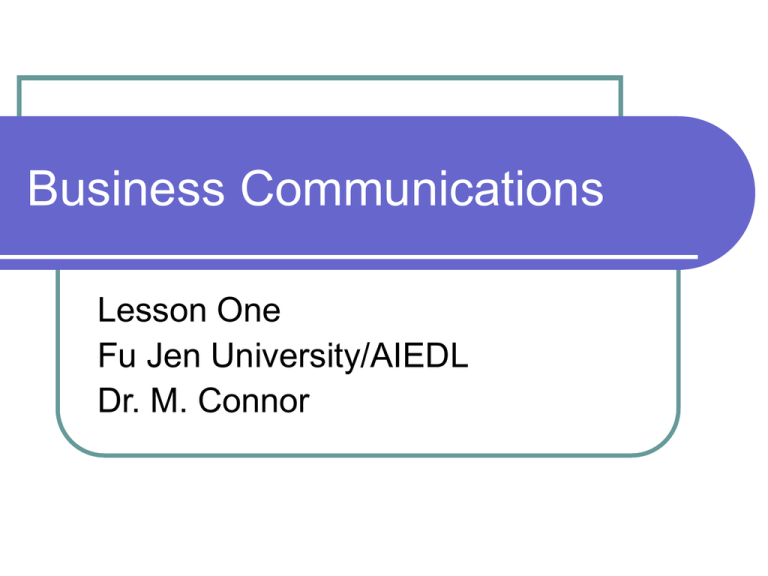
Business Communications Lesson One Fu Jen University/AIEDL Dr. M. Connor Very different course First off, you will not be doing academic writing. Business writing is sleeker, cleaner, and more concise. It is just as concerned with honesty, and plagiarism is just as large an issue as it is in academic writing, but in many ways, it’s a totally different species. Time is Money! We are taught it from an early age It’s one of the core tenants of our society. Just as you wouldn’t waste money, you shouldn’t waste time. Task/achievement oriented country That doesn’t mean Americans don’t care about people They simply tend to focus on business. Business at hand Things should be thorough enough to answer all the questions and include all pertinent information But no more than that. Task-oriented Cultures Spend most of their time on implementation and plan their life around the clock. Time is a tangible, precious commodity. The event dictates the person. Relationship-oriented Cultures Organize their life around people, not the clock. Time works for them; they don’t work for time. More time is spent developing relationships, and implementation happens very quickly once the relationship is set. The person dictates the event. Task-Relationship Illustration ACHIEVMENT RELATIONSHIP Sweden Japan Korea Australia Mexico Switzerland Brazil USA Germany England Netherlands Hong Kong India China/Taiwan France Saudi Arabia Your writing voice We want your writing lean, tough, effective, but also personal. As a writer and a teacher of writing, I believe that your voice should come through. I want my own style to come through in my writing, but in a way that presents my best professional self A branch of fillibabba.com I will run this course like I run my company. I will be grading you as if you worked for me. I will judge your writing as if it was going out into the world with my company name on it. Don’t panic! I will not be grading your writing for the first four weeks of class. Until then, writing will be pass/fail I’ll be making enough comments on the papers so that you will have a real idea of where you stand. What will we be doing? Consists almost entirely of writing assignments. Scenarios from real life you must role play in order to answer. One long formal business report Midterm and final. About business communications Thanks to technology, people today have to be better and stronger communicators. Workplaces have to have effective communication systems in place. Benefits to effective communication Quicker problem solving Stronger decision making Increased productivity Steadier work flow Stronger business relationships Clearer promotional materials Enhanced professional image, and Improved stakeholder response Telecommunications Increased the speed of communications Increased the need for good communicators E-commerce and e-education are just some of the new options opening up Even more need for skills One thing hasn’t changed—strong communication skills will move you upwards faster than poor communicators. How many job ads have you read requiring good communication skills? How do organizations communicate There are two main types of communication: internal communication external communication. Internal communication Means the exchange of information within the organization. This can further be broken down to two types: Formal Informal. Formal communications networks Can often be charted based on the structure of the organization. Information flows Down Up Across the structure, depending on the need Downward flow Most decisions are made at the top and flow downward. Each level must understand the message and pass it down. Usually this has to do with employees doing their jobs. Upward flow Helps managers solve problems and make intelligent decisions. Because executives can’t be everywhere, they depend on subordinates to furnish them with information. Horizontal flow When information moves from one department to another. This helps employees share information and coordinate tasks. Especially helpful when dealing with difficult or complicated problems. Informal information network Commonly called “the grapevine.” As people go about their day, they chat and share information. While some of this information is personal in nature, studies have shown that up to 80% is about the business. It can also be highly accurate. Useful tool or something to fear? Some management types worry about the grapevine perhaps because it can spread information they don’t want spread. But smart managers know how to use it to their advantage. External communications Like Internal communications, external communications also has: Formal style Informal style. Formal communications Letters Websites E-mails Faxes Anything that is going out with the company name on it. Crisis management One of the most visible tasks of formal external communication is crisis management. Excellence in communications can minimize damages during a crisis. Informal outside communication Much more subtle. It happens when members of an organization have informal contact with members of the public in real world situations in order to get feedback about the organization. This can be at conferences, conventions, entertainment venues. Understanding the communication process Communications is a two-way process that can be broken down into six steps. Step one The sender has an idea. You come up with an idea and want to share it. Step two The sender encodes the idea and sends it. When you put your idea into a message that the receiver will understand, you encode it, which means deciding on a message’s form (word, facial expression, gesture) length, organization, tone and style—all of which depend on your idea, audience and personal style or mood. Step three The sender transmits the message. You must select a medium—face-to-face, telephone, memo, letter, e-mail, and so on). This choice depends on your message, your audience’s location, your need for speed and the formality required. Step four The receiver gets the message. For communication to occur, your receiver must first get the message. Step five The receiver decodes the message. Your receiver must decode (absorb and understand) your message, which then must be stored in your receiver’s mind. If everything goes the way you plan, the receiver interprets your message correctly. Step six The receiver sends feedback, which is a fancy way of saying he or she answers you. Barriers to effective communication There are a number of barriers that can get in the way of effective communication. If you want to be an effective communicator, it’s good to know what these are. Perceptual differences Our perceptions of words can be different. I say the word chair, and a chair pops into your mind. But is it the same chair I mean? We may agree on the basic concept of chair, but the images differ. This can be made even worse by language differences. Biscuit anyone?? American biscuits English biscuits Other barriers Other barriers that can cause problems with perceptual differences are Age Education social status economic position Religion Life experiences. Restrictive environments When messages flow, they can change. If a management wants to restrict access, it can hinder communication both ways. Distractions These can be physical barriers like bad phone lines, poor faxes, illegible copies or poor acoustics. All of these can block proper transmission of a message. Discomforts like a bad chair, a too cold or too warm room or health problems can cause problems as well. Other distractions Your receiver might have poor listening skills. Sometimes we let our minds wander and then we can lose track of what’s being said. Emotional distractions play a part If you are angry, hostile, sad or fearful, you have a harder time of shaping a message successfully. If the receiver is the emotional one, he or she might distort your message. An emotional message or receiver give a greater potential for misunderstanding. Finally, the sheer number of communications we face each day at work can overwhelm us. Deceptive tactics Using certain words can color how we receive a message. Or deceptive communicators may exaggerate benefits, quote inaccurate statistics, hide negative data. They may state opinions as facts, leave out crucial information or portray graphic data unfairly. How do we overcome barriers There are five traits of effective communicators. Knowing what they are can help you improve your communications. 1. Perception Effective communicators are able to predict how you will receive their message. They anticipate your reaction and shape the message accordingly. They read your response correctly and constantly adjust to correct any misunderstanding. 2. Precision Effective communicators create a “meeting of the minds”. They make sure that you share the same mental picture. 3. Credibility Effective communicators are believable. You trust their intentions and their information. 4. Control Effective communicators shape your response. On some level we might call them manipulators, because they make you cry, laugh, take action. 5. Congeniality Finally, effective communicators maintain pleasant, friendly relations. Whether or not you agree with them, they command your respect and goodwill. Guidelines to help you communicate 1) adopting an audience-centered approach 2) fostering an open communication climate 3) creating lean, efficient messages 4) committing to ethical communication. Adopt audience-centered approach. Focus on and care about your audience. Try to find out as much about them as possible. If this isn’t possible because they are strangers, use common sense and a bit of imagination to get inside their heads. Foster open communications climate Encourage feedback. Effective managers are good communicators, and the best ones make sure they allow communication to flow upwards and well as down. Create lean, efficient messages Lean means no extra fat. It does not mean skinny or anorexic! If too much information is distracting, make sure you recognize what details are pertinent. This can also mean reducing the number of messages. Minimize distractions. You don’t have complete control over this one, but try to minimize physical and emotional barriers to communications. As a listener, try to be an active listener. Commit to ethical communications Ethics are the principles of conduct that governs a person or group. They are not situational, they are not in constant flux. There might be a grey area in life, but there is black and there is white. Ethical communication Do include all relevant information Do be true in every sense Do be deceptive in any way. Do be accurate and sincere. Don’t use language that manipulates, discriminates or exaggerates. Don’t hide negative information Don’t state opinions as facts Don’t portray graphic data fairly. Ethical dilemma Involves choosing among alternatives that aren’t clear-cut. This is when you’re working in the ”grey area”. Ethical lapse Making a clearly unethical or illegal choice. How to decide? One place to look is the law. If it is illegal, it is unethical. But in most cases, you have to rely on your own judgment. You might look at the consequences of your message and opt for the solution that provides the greatest good for the greatest number of people. Or you might look for the solution that you can live with Questions that can help There are four questions that can help you make your decision. Question 1 Is this message legal? Does it violate company policy or civil law? Question 2 Is this message balanced? Does it do the most good and the least harm? Is it fair to all concerned in the short term as well as the long term? Does it promote positive win-win relationships? Question 3 Is this a message you can live with? Does it make you feel good about yourself? Would you feel good about your decision if a newspaper published it? How about if your family knew about it? Question 4 Is this message feasible? Can it work in the real world? Company support Some companies foster ethical behavior by laying out a written code of ethics to help employees figure out what is acceptable. Marcus Tullius Cicero “What is morally wrong can never be advantageous, even when it enables you to make some gain that you believe to be to your advantage. The mere act of believing that some wrongful course of action constitutes an advantage is pernicious.” Statesman, orator, writer (106-43 BCE)
